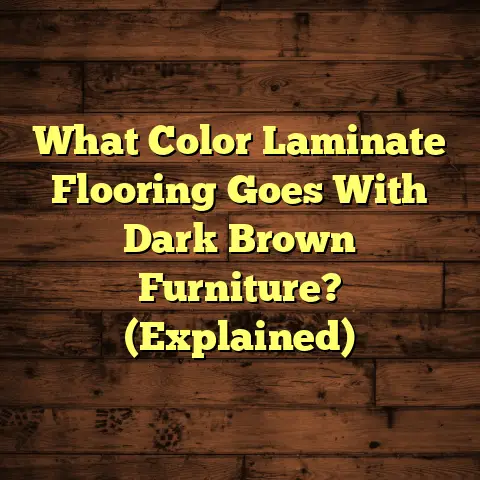How To Paint Wood Floors Black? (1-Day Transformation!)
I mean, really thought about it? Flooring is so much more than just something you walk on.
It’s the foundation of your room’s entire vibe, and it can totally make or break your design dreams.
Think about it: wood floors, in particular, are like the ultimate chameleon. They can rock any style, from rustic farmhouse to sleek modern.
And that’s where the magic of painting comes in.
We’re not just talking about slapping on some color; we’re talking about transforming your space with a statement.
Lately, I’ve been seeing a huge trend towards painted floors, and black? Black is where it’s at!
It’s bold, it’s chic, and it’s surprisingly versatile.
Plus, let’s be honest, sometimes those old wood floors are just begging for a makeover.
Painting is a fantastic way to breathe new life into them without breaking the bank.
So, buckle up, because we’re diving deep into the world of black-painted wood floors.
I’m going to show you how to turn your floors into a stunning focal point that reflects your unique personality and style. Let’s get started!
Section 1: Understanding the Appeal of Black Floors
Okay, let’s talk about why black floors are having a serious moment.
What’s the psychology behind choosing such a dramatic color for something you walk on?
Well, for starters, black exudes elegance and sophistication like no other color can.
It’s a statement. It says, “I have style, and I’m not afraid to show it.”
But it’s not just about making a splash. Black is also incredibly versatile.
Think about it: black goes with everything. It’s the ultimate neutral.
It provides a fantastic backdrop for pops of color, whether you’re into bright, bold hues or soft, muted tones.
I’ve seen black floors paired with everything from vibrant turquoise walls to minimalist white furniture, and it always looks stunning.
Historically, black wood floors have been used in grand estates and modern lofts alike.
They can add a touch of drama to a traditional setting or create a sleek, industrial vibe in a more contemporary space.
Take, for example, the iconic Coco Chanel’s apartment in Paris. The black and white checkered floors are legendary!
Or think about modern minimalist homes where black floors create a grounding contrast to bright white walls and furniture.
According to a study by the Color Marketing Group, black is often associated with power, authority, and mystery.
(Source: Color Marketing Group – Note: Specific study details may vary and are often proprietary to CMG members)
That translates into a sense of confidence and sophistication in your home.
Personally, I love how black floors can instantly elevate a space.
They create a sense of depth and drama that’s hard to achieve with lighter colors.
Plus, they can make your furniture and decor really pop!
So, if you’re looking to make a bold statement and add a touch of sophistication to your home, black floors might just be the perfect choice for you.
Section 2: Preparing for Your Project
Alright, before we dive headfirst into painting, let’s talk about preparation.
This is where you lay the groundwork for a flawless finish.
Trust me, skipping these steps is a recipe for disaster.
First things first: assess the condition of your wood floors.
Are there any major scratches, dents, or uneven spots?
You’ll need to address these before you even think about picking up a paintbrush.
I always tell my clients to get down on their hands and knees and really inspect the floors.
Look for any signs of damage, like water stains or warped boards.
If you find any serious issues, you might need to consider repairing or replacing those sections before painting.
Now, let’s talk tools and materials. Here’s a list of what you’ll need:
-
Quality Wood Floor Paint: This is crucial! Don’t skimp on this. Look for paint specifically designed for wood floors. It’s more durable and resistant to wear and tear. I personally recommend Benjamin Moore’s Advance or Sherwin-Williams’ Porch & Floor Enamel.
-
Primer: A good primer is essential for adhesion and preventing bleed-through. I prefer an oil-based primer for wood floors. Kilz Original is a solid choice.
-
Sandpaper (various grits): You’ll need a range of grits, from coarse to fine, to properly prep the surface. I usually start with 80-grit to remove any existing finish, then move to 120-grit and finally 220-grit for a smooth finish.
-
Paintbrushes and Rollers: Invest in high-quality brushes and rollers for a smooth, even application. I like using a 2-inch angled brush for edges and corners and a 9-inch roller with a 3/8-inch nap for the main surface.
-
Painter’s Tape: This is your best friend for protecting baseboards and trim. I always recommend using a high-quality painter’s tape like Frog Tape to prevent bleed-through.
-
Drop Cloths: Protect your furniture and belongings with drop cloths. Canvas drop cloths are more durable and eco-friendly than plastic ones.
-
Safety Gear: Don’t forget your gloves, mask, and goggles! You want to protect yourself from paint fumes and dust.
Make sure you have everything on hand before you start. There’s nothing worse than realizing you’re missing a crucial tool halfway through the project.
Take your time with the prep work. It’s the key to achieving a professional-looking finish that will last for years to come.
Section 3: Step-by-Step Guide to Painting Wood Floors
Alright, let’s get down to the nitty-gritty! Here’s a step-by-step guide to painting your wood floors black:
Step 1: Cleaning and Preparing the Surface
First, you need to thoroughly clean your floors. I’m talking spotless!
Use a vacuum cleaner to remove any loose dirt and debris.
Then, mop the floors with a wood floor cleaner. I recommend Bona Wood Floor Cleaner.
Make sure to follow the instructions on the product label.
Next up: sanding. This is where you create a smooth surface for the paint to adhere to.
Attach the 80-grit sandpaper to your orbital sander and start sanding the floors.
Make sure to sand in the direction of the wood grain.
Once you’ve removed the existing finish, switch to 120-grit sandpaper and sand again.
Finally, use 220-grit sandpaper for a super smooth finish.
After sanding, vacuum the floors thoroughly to remove any sanding dust.
Then, wipe the floors down with a tack cloth to pick up any remaining dust particles.
Now, it’s time to address any gaps or imperfections in the wood.
Use wood filler to fill in any cracks, holes, or dents.
Let the wood filler dry completely according to the manufacturer’s instructions.
Then, sand the filled areas smooth with 220-grit sandpaper.
Step 2: Priming the Floors
Priming is essential for ensuring that the paint adheres properly to the wood and prevents bleed-through.
Choose a high-quality oil-based primer specifically designed for wood floors.
I recommend Kilz Original.
Apply the primer evenly using a paintbrush or roller.
Make sure to cover the entire surface of the floor.
Allow the primer to dry completely according to the manufacturer’s instructions.
This usually takes at least 24 hours.
Step 3: Painting the Floors
Now for the fun part: painting!
Stir the black paint thoroughly before you start.
Apply the paint evenly using a paintbrush or roller.
Start with the edges and corners, using a 2-inch angled brush.
Then, use a 9-inch roller with a 3/8-inch nap to paint the main surface of the floor.
Work in small sections, overlapping each stroke slightly to ensure even coverage.
Apply a thin, even coat of paint.
Avoid applying too much paint, as this can lead to drips and runs.
Allow the first coat of paint to dry completely according to the manufacturer’s instructions.
This usually takes at least 24 hours.
Once the first coat is dry, apply a second coat of paint.
This will provide better coverage and durability.
Allow the second coat of paint to dry completely before moving on to the next step.
I usually recommend two coats of paint for optimal coverage and durability. However, depending on the type of paint you use, you may need to apply a third coat.
Step 4: Finishing Touches
To protect your painted floors and ensure their longevity, you need to apply a topcoat or sealant.
Choose a clear, durable topcoat specifically designed for wood floors.
I recommend Bona Traffic HD.
Apply the topcoat evenly using a paintbrush or roller.
Follow the manufacturer’s instructions for application and drying times.
I usually recommend applying two coats of topcoat for maximum protection.
Allow the topcoat to dry completely before walking on the floors.
This usually takes at least 24-48 hours.
Section 4: Maintenance of Painted Wood Floors
Alright, you’ve got your gorgeous black floors. Now, how do you keep them looking that way?
Maintenance is key!
Here are some tips for caring for your painted wood floors:
-
Regular Cleaning: Sweep or vacuum your floors regularly to remove dirt and debris. This will prevent scratches and wear. I recommend using a soft bristle broom or a vacuum with a soft brush attachment.
-
Gentle Mopping: Mop your floors with a wood floor cleaner. Avoid using harsh chemicals or abrasive cleaners, as these can damage the paint. I recommend Bona Wood Floor Cleaner.
-
Avoid Water Damage: Wipe up spills immediately to prevent water damage. Water can seep into the paint and cause it to peel or bubble.
-
Use Rugs and Mats: Place rugs and mats in high-traffic areas to protect the floors from wear and tear. This is especially important in entryways and hallways.
-
Avoid Heavy Furniture: Use felt pads underneath heavy furniture to prevent scratches and dents.
-
Periodic Touch-Ups: Over time, your painted floors may start to show signs of wear and tear. Touch up any scratches or chips with a small amount of paint.
I always tell my clients that proper maintenance is the key to keeping their painted floors looking beautiful for years to come.
Section 5: Troubleshooting Common Issues
Okay, let’s be real. Sometimes things don’t go exactly as planned.
Here are some common issues you might encounter when painting wood floors and how to fix them:
-
Bubbling: Bubbling can occur if the paint is applied too thickly or if the surface is not properly prepped. To fix bubbling, sand the affected area smooth and reapply the paint in a thin, even coat.
-
Peeling: Peeling can occur if the paint is not adhering properly to the surface. This can be caused by a dirty or oily surface, or by using the wrong type of primer. To fix peeling, sand the affected area down to bare wood and reapply the primer and paint.
-
Uneven Finish: An uneven finish can occur if the paint is not applied evenly or if the brush strokes are visible. To fix an uneven finish, sand the affected area smooth and reapply the paint in a thin, even coat. Use a high-quality brush or roller to avoid brush strokes.
-
Paint Not Drying: If your paint is not drying properly, it could be due to high humidity or low temperatures. Make sure to paint in a well-ventilated area and allow the paint to dry completely according to the manufacturer’s instructions.
-
Bleed-Through: Bleed-through can occur if the existing finish is bleeding through the paint. This is more common with dark or stained wood. To prevent bleed-through, use a high-quality oil-based primer. If bleed-through does occur, apply another coat of primer.
Don’t be discouraged if you encounter any of these issues. With a little bit of patience and effort, you can fix them and achieve a beautiful, professional-looking finish.
Conclusion: The Impact of Painted Floors on Home Aesthetics
So, there you have it! Painting your wood floors black is a fantastic way to transform your space and add a touch of elegance and sophistication.
It’s a relatively simple and affordable project that can have a huge impact on the overall look and feel of your home.
Remember, flooring is more than just something you walk on. It’s a canvas for artistic expression.
Don’t be afraid to experiment with color and design to create a space that reflects your unique personality and style.
A simple change, like painting your floors black, can lead to a refreshed atmosphere and transform your house into a home filled with character and style.
So, go ahead, grab a paintbrush and get creative! Your floors will thank you for it.





